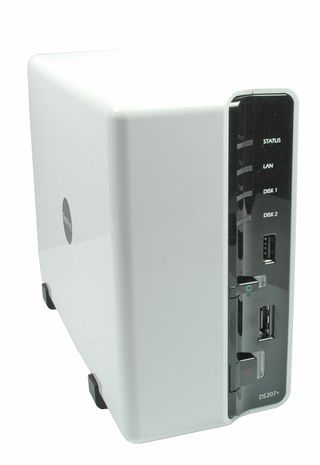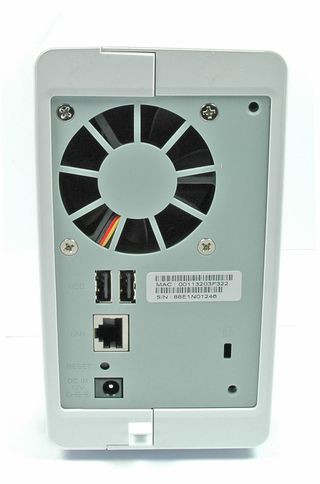Synology DS207+: Getting NAS Into Your Home
Build Quality and Accessories

The white plastic housing of the Synology DS207+ is solid and well-constructed, and the front of the housing is well-organized. LEDs inform you of the operating state of the hard drives, network activity, and the status of the Disk Station DS207+ itself. In addition to the On/Off button there is also a USB port and eSATA port on the front. Data from a USB storage media can be copied directly onto the Disk Station by using the "USB Copy” button on the front.

More USB Ports
There are two more USB ports on the back panel of the DS207+. The unit supports USB storage mediums formatted with the FAT and NTFS file systems. It also supports USB printers and connections to UPS devices. It naturally attaches to the network via Gigabit Ethernet port. There is a reset button on the back too, as well as a notch in the housing for a Kensington lock. The 60 mm fan generates air circulation to help cool the housing.
The DS207+ comes with an external power supply, which provides a maximum of 5.8 amps at 12 V.
Accessories

The Synology DS207+ doesn’t have hard drive racks, so the drives must be mounted directly to the device. This means a larger number of accessories compared to other NAS devices that do have mobile hard drive racks. In addition to the external power supply with power cord, you’ll find two SATA power and data cables, as well screws for mounting the hard drives. Also included are installation and quick-start manuals, a software CD, and an RJ-45 Ethernet cable.
Installation Of Hard Drives
Stay on the Cutting Edge
Join the experts who read Tom's Hardware for the inside track on enthusiast PC tech news — and have for over 25 years. We'll send breaking news and in-depth reviews of CPUs, GPUs, AI, maker hardware and more straight to your inbox.

After opening the housing, the hard drives can be mounted to the metal mount. A detailed installation manual explains where the different cables must be connected to the motherboard. Even users with a little bit of hardware experience can easily install the hard drives.
There is one significant disadvantage to not having hard drive racks—the NAS device must be turned off if a hard drive has to be replaced. This means there will be times when your data is not accessible.
SATA Controller and CPU from Marvell

Inside the Disk Station there is a Marvell 88F5281 processor, which is based on the ARM architecture. The CPU is clocked at 500 MHz and complemented by 128 MB of main memory. The thermal power loss of the CPU is so low that it doesn’t even need a passive cooler, which eliminates potential noise from an additional fan. The 88SX7042 PCIe-to-Serial ATA controller is also from Marvell, and is used on the RocketRAID 2300 PCI Express RAID controller from Highpoint as well.
Current page: Build Quality and Accessories
Prev Page Configuration and Operating Cost Next Page Web Interface And Test Setup-
It should be noted that Synology currently has an issue with their HD hibernation function and that it has not been solved for a long timeReply
http://www.synology.com/enu/forum/viewforum.php?f=83
Synology has to iron out this issue soon or stop advertising their NAS's as having HD hibernation! -
slomo4sho To be honest, I don't see any benefits of a NAS device over a budget HTPC build supporting multiple hard drives in raid 0 configuration with dual LAN.Reply
This is the third NAS write-up with a months time frame. How about a write-up of direct comparison between these NAS devices and a budget built HTPC configuration? -
This thing is over $300 withOUT HDDs! Why would I pay that much when a MiniPC goes $250? This thing is a box with a chipset. Let me know when the price is sub $100.Reply
-
aapocketz I agree with previous sentiments about the value of this at $300. You can go out and buy something like uATX or ITX board and a small case for similar money. There are drop in linux distros that will act as NAS boxes and provide web interfaces, rolling your own isn't that hard. Or pay a bit more and get something like the HP mediasmart home server for only $100 more. Lots more configurability.Reply
However I purchased a Maxtor Shared Storage II single drive unit for about 100 a couple years back (with built in 320GB, awesome deal). I like the simplistic nature of it, low power use, flawless drive standby, and it runs a USB print server reliably so I can print from any computer. I didn't want RAID since I "rsync" the data over the network for redundancy when my main computer is on (good thing too, I had to have the hard drive replaced under warranty). I didn't need gigE though I may look to move to it at some point.
So for the right price, these things can be nice, but are limiting. For instance my brother has a squeezebox and while the NAS had a itunes server, it cant run the slimserver. That would be no problem on a HTPC type build with linux or WHS. Other NAS have slimserver capability but I still posit that they are less flexible than a full buildup. I can live with that, but not for $300+ dollars.
-
I agree with Slomo4sho. There have been myriad writeups of these devices, and I suspect that the more avid readers of Tom's would probably prefer to build their own solution. How building one to trounce these purpose-built jobs while saving money? I'd be very interested to see what you can come up with. And why not do it with all Newegg parts, so we can all check it out?Reply
-
malveaux Good heavens,Reply
Another NAS writeup. Tom's. We don't need to see these. Folk who actually want/use NAS don't care about these expensive little cute "home/office" NAS boxes that cost as much as a computer minus the drives and minus, well, the computer. These little NAS boxes are basically targeting those `we know nothing and won't hire an IT guy' small office/groups thinking about what they overheard another group's IT junkie saying and figured it'd be easy cause they think they know everything; get home only to find out they just wasted money and have no clue what they're even going to do with the NAS.
But, whatever. Meh.
Anyone interested in NAS, this is __NOT__ the way to go about it. This is an expensive silly approach to it. NAS needs to be EXPANDABLE to add more drives to, it needs to have options for OS (Why use this thing when FreeNAS is free, or if you wanted something like windows server).
You can build a great little computer into a very nice case for this cost. -
aapocketz Geez malveaux.Reply
I don't disagree that these are kinda expensive, thats the listed retail price, they are consumer products and get marked down quickly.
But its not like its only market is stupid and ignorant people.
having a plug-in simple way to add basic storage to a network has value. Just like people go out and buy consumer routers (d-link, netgear, linksys).
Also I would like to be able to put freeNAS on a consumer dedicated NAS hardware, kinda like putting openWRT or tomato on a linux capable router.
-
snarfies1 aapocketzGeez malveaux.I don't disagree that these are kinda expensive, thats the listed retail price, they are consumer products and get marked down quickly.Reply
The problem is that this is NOT a new product - I remember looking these over almost a year ago when I was looking into a NAS setup. I'm not at all sure why this is being reviewed now. The price has not, in fact, gone down.
-
aapocketz ReplyThe problem is that this is NOT a new product - I remember looking these over almost a year ago when I was looking into a NAS setup. I'm not at all sure why this is being reviewed now. The price has not, in fact, gone down.
yeah, did a google search, you are right, it was released about a year ago. I feel like i just wasted my time reading this. Tomshardware has become disturbing in the last couple years.
wasn't there a dedicated small home networking subsite on toms a while back? Where did that go? -
I have a 207+ and love it. It does exactly what I wanted it to do. Power efficient and set and forget. Not everyone wants a dedicated pc to do something as simple as file hosting. These use less power, take up less space, and in my opinion, more dependable.Reply
Most Popular


